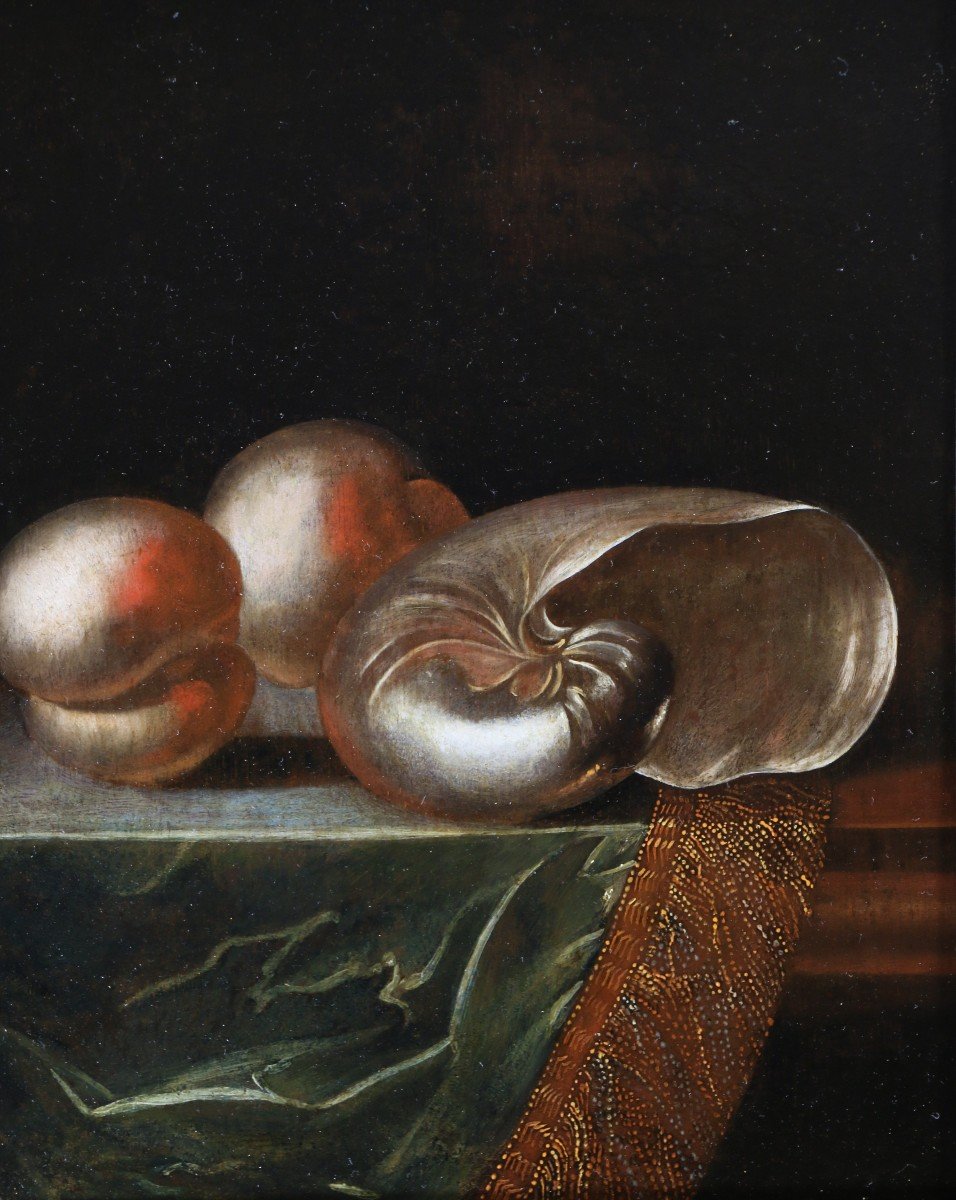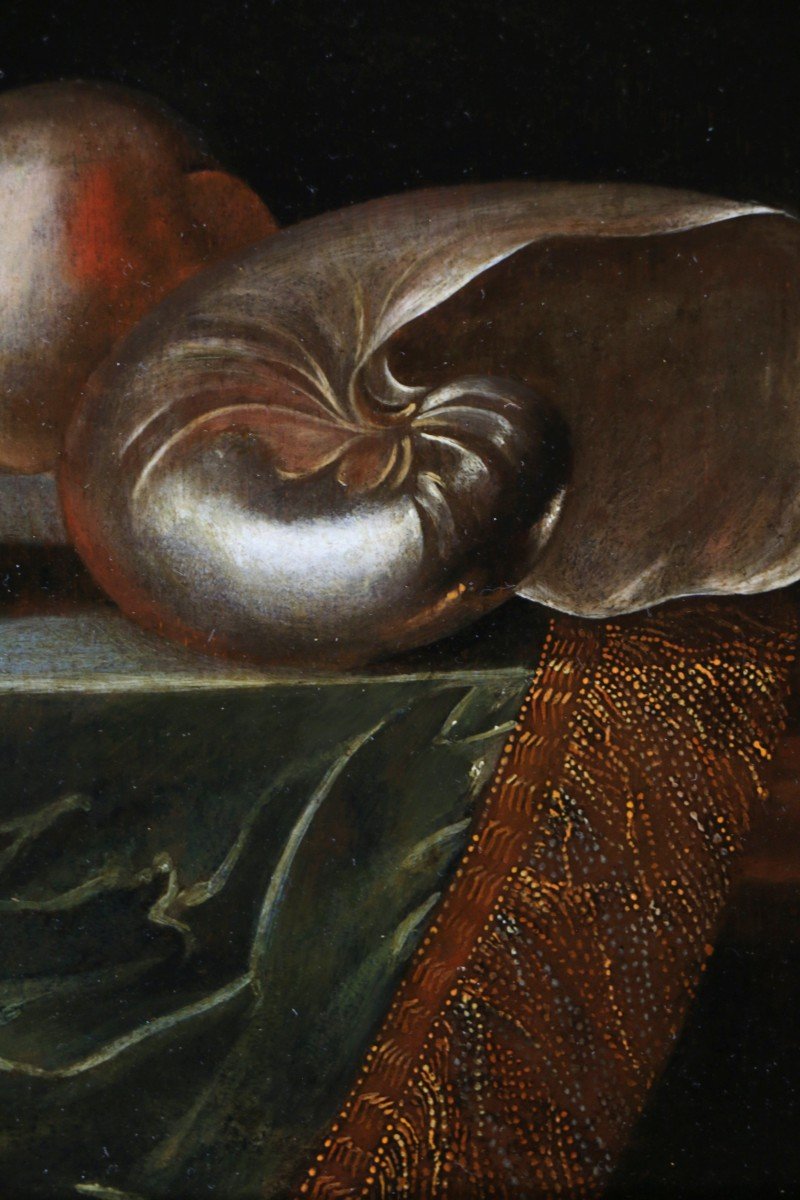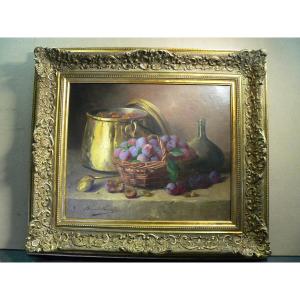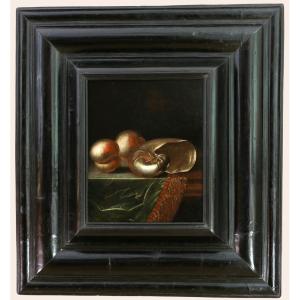Panel measuring 35 cm by 30 cm
Superb period frame measuring 70 cm by 64 cm
With this magnificent composition, the artist offers us an entablature partially covered with a tablecloth of green velvet, bordered of a rich fringe of silk and gold threads on which a pearly Nautilus and two peaches have been placed, all on a very dark background. Our research leads us to another work by Sebastian Stoskopff that can be admired at the L'oeuvre de Notre Dame museum in Strasbourg. Similar composition with variations. The tablecloth is blue in color, its frank presents an interesting and slight modification at the level of its braid. On our painting, we observe small chevrons instead of small lines (almost points). A chevron instead of a dot means that in our version and at this braid, the warp thread is much thicker than the weft thread. (Which forces the latter to come out longer above the warp thread and therefore to appear in the form of a chevron instead of a small line). The main difference is, of course, replacing the red coral with two peaches.
Stasbourg's work (photo on request) is documented in two books:
Eric Coatalem (French still life in the 17th century, Nautilus and coral page 320. Editions Faton)
Brigit Hahn Woernle (Sebastian Stoskopff, Nautilus und Koralle page 154. Edition Hatje
Sebastian Stoskopff (1597; 1657)
Born in 1597 in Strasbourg, a free city of the Empire that became Lutheran Protestantism in 1523, Sébastien Stoskopff did his first apprenticeship with a local painter. His father, official courier of the City, obtained in 1615 that the latter granted his son a scholarship so that he could go and perfect his skills in Hanau, with Daniel Soreau, a humanist painter who prided himself on making his young disciple a " new Dürer". When Daniel Soreau died in 1619, it was Stoskopff who liquidated his workshop, proof that he had become his second. In 1622 he asked for a permit to settle in Frankfurt, which was refused. His trace therefore becomes very discontinuous: he stays in Paris, but he is reported in Venice in 1629 then in Troyes. In 1636, he lived in Paris in the Marais, near the rue Vieille-du-Temple, and enjoyed a certain notoriety as suggested by the presence of his works in the greatest collections of the time. As soon as he arrived in Paris, Sébastien Stoskopff oriented his art in many directions and tackled themes as varied as the still lifes of books - the sumptuous Still life with books and candlelight painted in 1625 and kept in Rotterdam (Boymans van Beuningen museum ) is one of the first of its kind, the representations of the five senses, of vanity; he also creates "set tables" and very original kitchens which are perfectly in line with the evolution of the Parisian production of Jacques Linard, Lubin Baugin and Louise Moillon with whom he maintains close relations. The originality of Stoskopff's works nevertheless lies in their composition and in the particular treatment of light. In 1641, Sébastien Stoskopff returned to Strasbourg which, relatively unaffected by the troubles of the Thirty Years' War, was then a living artistic and intellectual center and he quickly found his place there. He obtains, not without difficulty, to be admitted into the guild of painters without producing the traditional masterpiece. He thanks the magistrate for this distinction by offering him a superb painting, which will be destroyed at the town hall by the riot of July 21, 1789. He marries in 1646 the daughter of a very prominent Strasbourg goldsmith, soon finds the father of a daughter. His works are marked by both continuity and innovation: kitchen scenes, lunches are always present, as are the vanities which he presents with the Grande Vanité (1641, Strasbourg, Musée de l'Œuvre Notre -Lady) a masterful interpretation. But new subjects appear: goldsmithery and glass baskets, and striking trompe-l'oeil. His clients were German princes who had taken refuge in the Alsatian capital; it is with one of them, Count Johannes of Nassau-IdStein that he dies, in obscure circumstances, perhaps assassinated.





























 Le Magazine de PROANTIC
Le Magazine de PROANTIC TRÉSORS Magazine
TRÉSORS Magazine Rivista Artiquariato
Rivista Artiquariato
